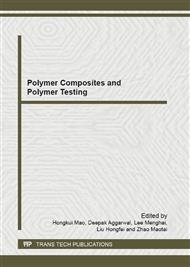p.44
p.49
p.53
p.58
p.63
p.67
p.72
p.76
p.80
Preparation Mechanism of Electrostatic Self-Assembled Polyelectrolyte Film Using Quartz Crystal Microbalance
Abstract:
Electrostatic layer-by-layer (LbL) self-assembly is widely used in sequential adsorption of nanometer-thick monolayers of oppositely charged polyelectrolytes to form a multi-layer film with molecular-level control over the architecture. To offer functional material for the potential application, this paper exploits PDDA and PSS as polycation and polyanion for LbL self-assembly to fabricate polyelectrolyte nanocomposite films. The preparation and film-growing mechanism is investigated under the influences of multi-factor such as polyelectrolyte concentration, ionic strength, and assembling duration using quartz crystal microbalance (QCM). The research results indicate the formation mechanism of multi-layer PDDA/PSS films and offer fundamental basis for the optimum preparation of polyelectrolyte films.
Info:
Periodical:
Pages:
63-66
Citation:
Online since:
April 2012
Authors:
Price:
Сopyright:
© 2012 Trans Tech Publications Ltd. All Rights Reserved
Share:
Citation:


